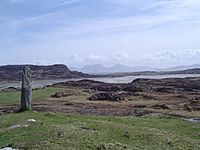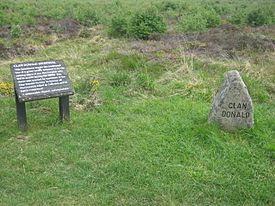Clan Donald facts for kids
Quick facts for kids Clan Donald |
|||
|---|---|---|---|
| Clann Dòmhnaill, Na Dòmhnallaich | |||
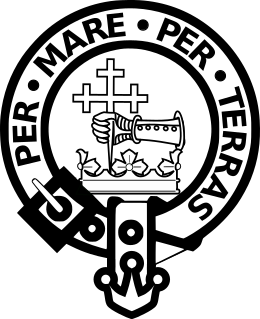
Crest: On a crest coronet Or, a hand in armor fessways couped at the elbow proper holding a cross crosslet fitchy Gules.
|
|||
| Motto | Per mare per terras ('by sea and by land') | ||
| War cry | Fraoch eilean ('the heathery isle') | ||
| Profile | |||
| Region | Highland and Islands | ||
| District | Inner Hebrides Ross |
||
| Plant badge | Common heath | ||
| Chief | |||
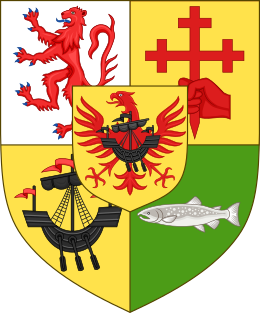 |
|||
| Godfrey James Macdonald of that Ilk | |||
| The 8th Baron Macdonald, Chief of the Name and Arms of Macdonald, High Chief of Clan Donald and 34th hereditary Chief of Clan Donald. | |||
| Historic seat | Finlaggan Castle | ||
|
|||
|
|||
|
|||
|
|||
|
|||
Clan Donald, also known as Clan MacDonald, is a large and important Scottish clan from the Highlands of Scotland. The Lord Lyon King of Arms is a Scottish official who deals with coats of arms and family histories. He officially recognizes the High Chief of Clan Donald. In the past, the chiefs of Clan Donald were known as the Lord of the Isles until 1493. Some chiefs also held the title of Earl of Ross.
Many different branches belong to Clan Donald. Several of these branches have their own chiefs recognized by the Lord Lyon King of Arms. These include Clan Macdonald of Sleat, Clan Macdonald of Clanranald, Clan MacDonell of Glengarry, Clan MacDonald of Keppoch, and Clan MacAlister. Other important historical branches of Clan Donald, like the Clan MacDonald of Dunnyveg and Clan MacDonald of Glencoe, do not have recognized chiefs today. The MacDonnells of Antrim are a related family in Northern Ireland.
History of Clan Donald
Where Did Clan Donald Come From?
The Clan Donald family comes from a mix of Norse (Viking) and Gaelic (Scottish/Irish) people. Their story begins with Dòmhnall Mac Raghnuill, who lived around 1250. His father, Ranald, was called "King of the Isles." Ranald's father, Somerled, was known as "King of the Hebrides." Somerled died in a battle in 1164.
Clan Donald shares its family tree with Clan MacDougall. Both clans come from Somerled. Their families are often called the Clann Somhairle. They also have family ties to the kings of Mann and the Isles and the Earls of Orkney through Somerled's wife.
Old Gaelic historians, called seanchaidhean, believed Somerled's family came from ancient High Kings of Ireland. This meant Clan Donald claimed to be "Children of Colla" and "Seed of Conn," linking them to famous Irish kings. An old poem from 1411, before the Battle of Harlaw, encouraged the clan by saying, "Ye children of Conn remember hardihood in the time of battle."
However, modern DNA studies have shown that Somerled's male family line was actually of Norse (Viking) origin. By testing the DNA of men with surnames like MacDonald and MacDougall, scientists found they shared a unique DNA marker. This marker is often found in people of Norse descent in Britain and Ireland.
Scottish-Norwegian War (1263)
In 1263, Alexander III of Scotland defeated Haakon IV of Norway at the Battle of Largs. The Clan Donald chief, Aonghas Mor, and his clan were loyal to the Norwegian king. After the battle, the King of Scots became their new ruler. This was confirmed in the Treaty of Perth.
Supporting Robert the Bruce
Aonghus Óg of Islay, son of Aongus Mor, strongly supported Robert the Bruce during the Wars of Scottish Independence. He fought with Bruce at the famous Battle of Bannockburn in 1314. Because of Clan Donald's help, King Robert the Bruce declared that Clan Donald would always stand on the right side of the Scottish army. This was a very honored position.
Clan Donald in the 15th and 16th Centuries
Becoming Earls of Ross
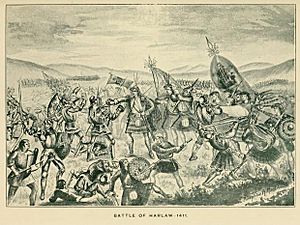
The title of Earl of Ross was very important. It had been held by the chief of Clan Ross. But then it passed to another family. However, Donald of Islay, Lord of the Isles, who was the grandson of Angus Og, married Mariota, Countess of Ross. She was the rightful heir to the Earldom of Ross. Because of this marriage, Donald later claimed the title for himself.
In 1411, Donald captured Dingwall Castle, an important place in Ross. He had defeated the powerful Clan Mackay at the Battle of Dingwall. This led to the Battle of Harlaw on July 24, 1411. Donald of Islay's army, which may have had 10,000 men, fought against the forces of the Duke of Albany. Although Donald won a victory, he did not continue to Aberdeen. He took his army back to the Western Highlands.
Later, in 1429, the Battle of Lochaber happened. Donald's son, Alexander of Islay, fought against the king's army. Two years later, in 1431, the Battle of Inverlochy (1431) took place. While Alexander was in prison, his nephew, Donald Balloch MacDonald, led Clan MacDonald. They defeated the royal army. The MacDonald Lords of the Isles were very strong. They were one of the few groups in Scotland who could defeat the king's forces at that time.
Eventually, King James I agreed to Alexander's rule in the Isles and Ross. So, the MacDonald chiefs became the Earls of Ross. First, Alexander of Islay, Earl of Ross, became Earl in 1437. Then, his son, John of Islay, Earl of Ross, held the title. However, John gave up the earldom to the King in 1475.
Losing Power
In 1475, James III of Scotland took away the MacDonald Earldom of Ross. The MacDonald Lordship of the Isles was officially lost in 1493. But 1475 was really the end of their great power. After this, there was a big struggle for power among the Gaelic clans. Many MacDonald leaders tried to get their power back. These included Aonghas Óg and his son, Domhnall Dubh.
The Battle of Bloody Bay happened in 1480. In this battle, John MacDonald of Islay, the Lord of the Isles, was defeated by his own son, Aonghas Óg. Aonghas Óg's son, Domhnall Dubh, later rebelled against James IV of Scotland. He even made a deal with Henry VIII of England to try and get the Lordship of the Isles back. But all these attempts failed by 1545.
The Scottish Crown worked to keep Clan Donald divided. They gave separate land titles to the different MacDonald branches. This made the clan less of a threat to the king's power.
The MacDonnells of Antrim in Northern Ireland were a part of Clan Donald. Many MacDonnells moved to Ireland in the early 1500s.
Clan Donald in the 17th Century
Losing the Lordship of the Isles greatly affected the MacDonalds. They held lands on both sides of the Irish Sea, but not as one strong area. Their efforts to regain control caused problems in Western Scotland for many years. A new law called 'Slaughter under trust' was created in 1587. This law aimed to stop the constant fighting between clans. It meant that if someone was killed after they had surrendered or been welcomed as a guest, it was a serious crime.
In 1568, the Scottish Reformation changed Scotland's church to Presbyterianism. By 1640, very few Scots were Catholic. Most Catholics lived in places like South Uist, controlled by Clanranald. This religious difference caused problems for the MacDonalds. It split them into Catholic and Presbyterian groups. This split had terrible results for the Glencoe MacDonalds in 1692.
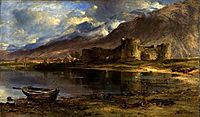
The Wars of the Three Kingdoms (1638-1651) caused great trouble across Britain and Ireland. In 1641, Scottish forces joined the Irish Rebellion of 1641. Both sides committed cruel acts. In 1642, on Rathlin Island, soldiers from a unit mostly made up of Clan Campbell members caused the deaths of many MacDonnell women.
In 1644, Alasdair Mac Colla arrived in Scotland with Irish troops. He joined the Scottish Royalists. Alasdair was from Clan MacDonald of Dunnyveg. His clan had lands in both western Scotland and Ireland. They joined Montrose and helped him win many battles in 1644-1645. They won a big victory at the Battle of Inverlochy (1645). This battle gave Montrose control of Scotland for a time.
The Inverlochy battle is often seen as a fight between Campbells and MacDonalds. While this is partly true, many other groups were involved. The campaign ended in failure because Mac Colla wanted to get back lands in the Highlands, while Montrose wanted to help King Charles. They split up. Mac Colla's destruction of Campbell lands was remembered for a very long time.
The Massacre of Glencoe happened in 1692. Thirty-eight unarmed MacDonalds from the Clan MacDonald of Glencoe were killed. This happened because the chief, MacIain, was late in signing an oath of loyalty to William III of England. This event was so shocking that it helped inspire "The Red Wedding" in the Game of Thrones books and TV series.
Clan Donald in the 18th Century
The Jacobite Risings
During the Jacobite rising of 1715, many MacDonalds supported the House of Stuart. This family believed they were the rightful kings of Britain. Men from Clan MacDonald of Keppoch and Clan Macdonald of Clanranald fought at the Battle of Sheriffmuir in 1715. The chief of Clanranald was killed there. The Clan MacDonald of Glencoe also fought at this battle.
Later, during the Jacobite rising of 1745, the Clan MacDonell of Glengarry, Clan MacDonald of Keppoch, and the MacDonalds of Glencoe fought for the Jacobites at the Battle of Prestonpans in 1745.
These same clans, along with Clan MacDonald of Clanranald, also fought as Jacobites at the Battle of Falkirk Muir in 1746.
Finally, at the Battle of Culloden in April 1746, the Clan MacDonald of Glencoe, Clan MacDonald of Clanranald, and Clan MacDonell of Glengarry fought for the Jacobites. The chief of Clan MacDonald of Keppoch was killed there.
The Clan MacDonald of Sleat branch had supported the Jacobites in 1715. However, in the 1745 rebellion, they actually formed two groups to support the British Government. Because of this, their lands remained safe. But some historians say these groups were not very helpful to the Government. This is because many of their officers and men secretly supported the Jacobite Prince Charles Edward Stuart.
Clan Chief
In 1947, Alexander Godfrey Macdonald was recognized as the first High Chief of Clan Donald. After he passed away in 1970, his son, Godfrey James Macdonald, became the current High Chief. In 1972, the MacDonald family lands were sold to pay taxes. Lord Macdonald now lives at Kinloch Lodge on the Isle of Skye with his wife, Claire Macdonald.
Early Clan Chiefs
Here are some of the early chiefs of Clan Donald:
| Name | Died | Notes |
|---|---|---|
| Dòmhnall Dubh | 1545 | He fought against the King of Scots and made a deal with the King of England. |
| Aonghas Òg | 1490 | He was a son of John of Islay. He was the last MacDonald Lord of the Isles. |
| John of Islay, Earl of Ross | 1503 | He fought against his own son at the Battle of Bloody Bay. |
| Alexander of Islay, Earl of Ross | 1449 | His sons started the Macdonald of Lochalsh and Macdonalds of Sleat branches. |
| Dòmhnall of Islay, Lord of the Isles | 1422/3 | He won the Battle of Harlaw. |
| John of Islay, Lord of the Isles | 1380 | He married Amy of Garmoran, and their son Ranald founded Clanranald. His second marriage led to the main Lords of the Isles line. His other sons started the MacDonnells of Antrim and Macdonald of Keppoch branches. |
| Aonghus Óg of Islay | 1314×1318/c.1330 | He fought at the Battle of Bannockburn. One of his sons started the Macdonalds of Glencoe branch. |
| Domhnall of Islay | ×1318? | His exact family ties are not fully clear. He may have been the MacDonald chief killed in battle in 1318. |
| Alexander Og MacDonald, Lord of Islay | 1299? | There are different ideas about when this son of Angus Mor died. He may have been killed in Ireland in 1299 or captured by Robert the Bruce in 1308. His brother, Angus Og, became chief in 1308. |
| Aonghas Mór (Angus Mor MacDonald) | c. 1293 | He was the father of Alexander Og, Aonghus Óg of Islay, and John Sprangach, who started the Macdonalds of Ardnamurchan branch. |
| Dòmhnall Mac Raghnuill (Donald) | Clan Donald gets its name from him. |
Clan Donald Castles
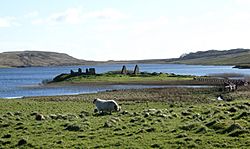
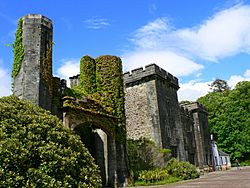
Over many years, the MacDonalds have lived in and owned several castles:
Main Clan Donald Castles
- Finlaggan Castle was on an island in Loch Finlaggan, on the Isle of Islay. It was the main home of the chief of Clan Donald, the Lord of the Isles.
- Armadale Castle on the Isle of Skye was started in 1815. Today, it is home to the Clan Donald Centre and the Museum of the Isles, which you can visit.
- Knock Castle (Isle of Skye) is a ruined MacDonald castle on the Isle of Skye.
- Duntulm Castle is another ruined MacDonald castle on the Isle of Skye.
- Aros Castle is a ruined MacDonald castle on the Isle of Mull.
- Claig Castle is a ruined MacDonald castle on the Isle of Jura.
- Kildonan Castle is a ruined MacDonald castle on the Isle of Arran.
- Ardtornish Castle is a ruined MacDonald castle on the Morvern peninsula.
- Dunaverty Castle, a ruined MacDonald castle off the coast of Kintyre, is also known as Blood Rock because of a sad event there.
Castles of Clan Donald Branches
- Castle Tioram, in Loch Moidart, Lochaber, was the home of the Clan Macdonald of Clanranald.
- Borve Castle, Benbecula was another castle of the MacDonalds of Clanranald.
- Ormiclate Castle was also a castle of the Macdonalds of Clanranald.
- Invergarry Castle, built on the Rock of the Raven, was the home of the Clan MacDonnell of Glengarry.
- Strome Castle on the shore of Loch Carron was an older castle of the MacDonnells of Glengarry.
- Dunluce Castle in Ireland was the home of the Clan MacDonnell of Antrim.
- Glenarm Castle in Ireland was another castle of the MacDonnells of Antrim.
- Dunyvaig Castle on the Isle of Islay was the home of the Clan MacDonald of Dunnyveg.
- Gorm Castle, on an island in Loch Gorm on Islay, was another home of the Clan MacDonald of Dunnyveg.
- Island Muller Castle in Kintyre was another home of the Clan MacDonald of Dunnyveg.
- Dunscaith Castle (Dun Sgathaich) on the Isle of Skye was the home of the Clan MacDonald of Sleat.
- Keppoch Castle, near Spean Bridge in Lochaber, was the home of the Clan MacDonald of Keppoch until 1690.
- Mingary Castle in Kilchoan, Lochaber, was the home of the Clan MacDonald of Ardnamurchan.
- Largie Castle, Rhunahaorine was the home of the Clan MacDonald of Largie.
Clan Tartans
| Tartan image | Notes |
|---|---|
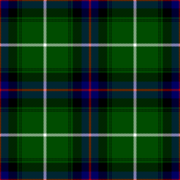 |
This is the MacDonald of the Isles tartan. It was published in a book called the Vestiarium Scoticum in 1842. |
See also
- Gaelic nobility of Ireland
- Keppoch murders
- Macdonald (surname article)
- Clandonald, Alberta, Canada


